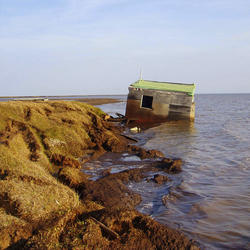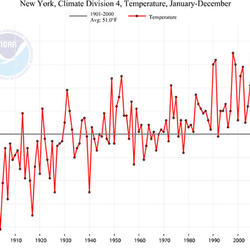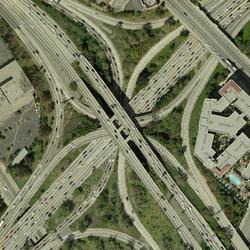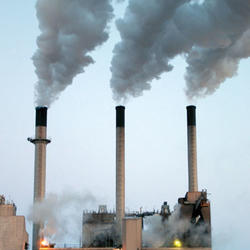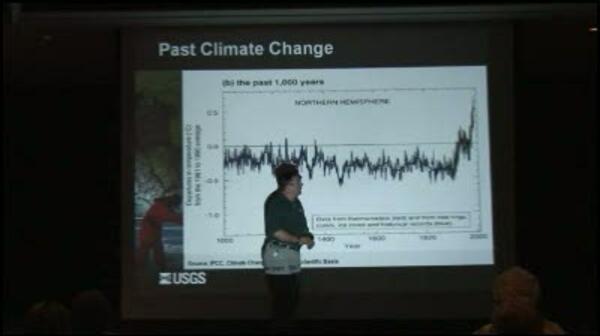Phragmites invades coastal wetland in a changing climate. Ottawa National Wildlife Refuge, Oak Harbor, OH. Photo Credit: Kurt Kowalski, USGS-GLSC.
What are some of the signs of climate change?
• Temperatures are rising world-wide due to greenhouse gases trapping more heat in the atmosphere.
• Droughts are becoming longer and more extreme around the world.
• Tropical storms becoming more severe due to warmer ocean water temperatures.
• As temperatures rise there is less snowpack in mountain ranges and polar areas and the snow melts faster.
• Overall, glaciers are melting at a faster rate.
• Sea ice in the Arctic Ocean around the North Pole is melting faster with the warmer temperatures.
• Permafrost is melting, releasing methane, a powerful greenhouse gas, into the atmosphere.
• Sea levels are rising, threatening coastal communities and estuarine ecosystems.
Related
Does an increase in the 100-year flood estimate originate from climate or land-use change?
What are the long-term effects of climate change?
What is the difference between weather and climate change?
How can climate change affect natural disasters?
How do changes in climate and land use relate to one another?
How do we know the climate is changing?
What is the difference between global warming and climate change?
Why is climate change happening and what are the causes?
How do we know glaciers are shrinking?
How does carbon get into the atmosphere?
How much carbon dioxide does the United States and the World emit each year from energy sources?
What is carbon sequestration?

Phragmites invades coastal wetland in a changing climate. Ottawa National Wildlife Refuge, Oak Harbor, OH. Photo Credit: Kurt Kowalski, USGS-GLSC.
Eroding permafrost on Alaska’s Arctic Coast. Inundation of permafrost like this produced subsea permafrost
Eroding permafrost on Alaska’s Arctic Coast. Inundation of permafrost like this produced subsea permafrost

This image shows the perimeter of Rainbow Glacier in Glacier National Park: 1966, 1998, 2005, 2015.
This image shows the perimeter of Rainbow Glacier in Glacier National Park: 1966, 1998, 2005, 2015.
 USGS Public Lecture: Warm Ice—Dynamics of Rapidly Changing Glaciers
USGS Public Lecture: Warm Ice—Dynamics of Rapidly Changing Glaciers
- Glacier Numerology – The how big, how long, how thick, how much, how often, of glacier science.
- Glacier Photography – While a picture may be worth a thousand words, a collection of images may tell a complete forensic story.
- Glacier Numerology – The how big, how long, how thick, how much, how often, of glacier science.
- Glacier Photography – While a picture may be worth a thousand words, a collection of images may tell a complete forensic story.
Jay Hootch, former employee of Yupitt of Andreafski, drills to take winter chemistry samples to be used in a permafrost loss study in the Yukon River Basin.
Jay Hootch, former employee of Yupitt of Andreafski, drills to take winter chemistry samples to be used in a permafrost loss study in the Yukon River Basin.
Heading out to take water chemistry samples for a study on permafrost in the Yukon River Basin. The study examined the chemical and hydrological changes occurring in the basin due to permafrost loss.
Heading out to take water chemistry samples for a study on permafrost in the Yukon River Basin. The study examined the chemical and hydrological changes occurring in the basin due to permafrost loss.
Barter Island sits at the top of the Arctic National Wildlife Refuge in Alaska, and with the Arctic facing quickly rising temperatures, USGS wants to investigate what’s causing the North Slope bluffs to erode so quickly.
Barter Island sits at the top of the Arctic National Wildlife Refuge in Alaska, and with the Arctic facing quickly rising temperatures, USGS wants to investigate what’s causing the North Slope bluffs to erode so quickly.

Allen Bondurant measuring the depth to permafrost along a thermokarst lake shore.
Allen Bondurant measuring the depth to permafrost along a thermokarst lake shore.

Neal Pastick – lead author of the study – investigating erosion along Alaska’s Arctic coastline near the village of Kaktovik. Permafrost-dominated coasts of Alaska have drastically changed as the result of coastal transgression and storm-surge flooding which can result in the loss of cultural sites and damage to infrastructure. Photo by M.
Neal Pastick – lead author of the study – investigating erosion along Alaska’s Arctic coastline near the village of Kaktovik. Permafrost-dominated coasts of Alaska have drastically changed as the result of coastal transgression and storm-surge flooding which can result in the loss of cultural sites and damage to infrastructure. Photo by M.
 PubTalk 11/2012 — Understanding Climate-Wildlife Relationships
PubTalk 11/2012 — Understanding Climate-Wildlife Relationships
-- are American pikas harbingers of changing conditions?
by USGS Research Ecologist Erik Beever
-- are American pikas harbingers of changing conditions?
by USGS Research Ecologist Erik Beever
The white colored rock (approximately 100ft high) shows the drop in the water level of Lake Mead as a result of the ongoing 10-year drought along the Colorado River.
The white colored rock (approximately 100ft high) shows the drop in the water level of Lake Mead as a result of the ongoing 10-year drought along the Colorado River.
 PubTalk 3/2010 — Changing Times-- A Changing Planet!
PubTalk 3/2010 — Changing Times-- A Changing Planet!
Using phenology to take the pulse of our planet
By Jake F. Weltzin, Executive Director, USA National Phenology Network
Using phenology to take the pulse of our planet
By Jake F. Weltzin, Executive Director, USA National Phenology Network
 USGS Public Lecture Series: Baked Alaska--What's Happening to the Glaciers in Alaska?
USGS Public Lecture Series: Baked Alaska--What's Happening to the Glaciers in Alaska?
Glaciers are Earth's largest reservoir of freshwater. As they change, so does global sea level. Alaska has one of the largest accumulations of glaciers anywhere on Earth outside of the Polar regions. For most of the past half century, Alaska has experienced a significant increase in temperature that has profoundly impacted its glaciers. Join USGS scientist Dr.
Glaciers are Earth's largest reservoir of freshwater. As they change, so does global sea level. Alaska has one of the largest accumulations of glaciers anywhere on Earth outside of the Polar regions. For most of the past half century, Alaska has experienced a significant increase in temperature that has profoundly impacted its glaciers. Join USGS scientist Dr.
Climate change is an issue of increasing public concern because of its potential effects on land, water, and biological resources.
Climate change is an issue of increasing public concern because of its potential effects on land, water, and biological resources.
 USGS Public Lecture Series: Watching Nature's Clock: A Citizen-Scientist Effort to Track Seasonal Signs of Climate Change
USGS Public Lecture Series: Watching Nature's Clock: A Citizen-Scientist Effort to Track Seasonal Signs of Climate Change
USGS Public Lecture Series: Watching Nature's Clock: A Citizen-Scientist Effort to Track Seasonal Signs of Climate Change
linkA new USGS program, the USA National Phenology Network, is recruiting tens of thousands of volunteers to team up with scientists to help track the effects of climate on seasonal patterns of plant and animal behavior.
USGS Public Lecture Series: Watching Nature's Clock: A Citizen-Scientist Effort to Track Seasonal Signs of Climate Change
linkA new USGS program, the USA National Phenology Network, is recruiting tens of thousands of volunteers to team up with scientists to help track the effects of climate on seasonal patterns of plant and animal behavior.
 Drew Point, AK Time-Lapse Photography of Coastal Erosion
Drew Point, AK Time-Lapse Photography of Coastal Erosion
4-week time-lapse photography of the Arctic coast at Drew Point, AK shows intense coastal erosion in early July, 2008
4-week time-lapse photography of the Arctic coast at Drew Point, AK shows intense coastal erosion in early July, 2008

Crumbling blocks of permafrost along the Beaufort Coast
Crumbling blocks of permafrost along the Beaufort Coast
California's hotter drought has already killed millions of trees, particularly in low-elevation forests.
California's hotter drought has already killed millions of trees, particularly in low-elevation forests.
The Vegetation Drought Response Index (VegDRI) incorporates satellite observations of vegetation to monitor at a finer spatial detail than other commonly used drought indicators.
The Vegetation Drought Response Index (VegDRI) incorporates satellite observations of vegetation to monitor at a finer spatial detail than other commonly used drought indicators.
Climate change and future water availability in the United States
Approaches for using CMIP projections in climate model ensembles to address the ‘hot model’ problem
Characterizing urban heat islands across 50 major cities in the United States
U.S. Geological Survey Benchmark Glacier Project
Monitoring and assessing urban heat island variations and effects in the United States
Using information from global climate models to inform policymaking—The role of the U.S. Geological Survey
Ecosystem vulnerability to climate change in the southeastern United States
Desert wetlands—Archives of a wetter past
Climate change: evaluating your local and regional water resources
The United States National Climate Assessment - Alaska Technical Regional Report
State of the Earth’s cryosphere at the beginning of the 21st century: Glaciers, global snow cover, floating ice, and permafrost and periglacial environments
Fifty-year record of glacier change reveals shifting climate in the Pacific Northwest and Alaska, USA
Related
Does an increase in the 100-year flood estimate originate from climate or land-use change?
What are the long-term effects of climate change?
What is the difference between weather and climate change?
How can climate change affect natural disasters?
How do changes in climate and land use relate to one another?
How do we know the climate is changing?
What is the difference between global warming and climate change?
Why is climate change happening and what are the causes?
How do we know glaciers are shrinking?
How does carbon get into the atmosphere?
How much carbon dioxide does the United States and the World emit each year from energy sources?
What is carbon sequestration?

Phragmites invades coastal wetland in a changing climate. Ottawa National Wildlife Refuge, Oak Harbor, OH. Photo Credit: Kurt Kowalski, USGS-GLSC.
Phragmites invades coastal wetland in a changing climate. Ottawa National Wildlife Refuge, Oak Harbor, OH. Photo Credit: Kurt Kowalski, USGS-GLSC.
Eroding permafrost on Alaska’s Arctic Coast. Inundation of permafrost like this produced subsea permafrost
Eroding permafrost on Alaska’s Arctic Coast. Inundation of permafrost like this produced subsea permafrost

This image shows the perimeter of Rainbow Glacier in Glacier National Park: 1966, 1998, 2005, 2015.
This image shows the perimeter of Rainbow Glacier in Glacier National Park: 1966, 1998, 2005, 2015.
 USGS Public Lecture: Warm Ice—Dynamics of Rapidly Changing Glaciers
USGS Public Lecture: Warm Ice—Dynamics of Rapidly Changing Glaciers
- Glacier Numerology – The how big, how long, how thick, how much, how often, of glacier science.
- Glacier Photography – While a picture may be worth a thousand words, a collection of images may tell a complete forensic story.
- Glacier Numerology – The how big, how long, how thick, how much, how often, of glacier science.
- Glacier Photography – While a picture may be worth a thousand words, a collection of images may tell a complete forensic story.
Jay Hootch, former employee of Yupitt of Andreafski, drills to take winter chemistry samples to be used in a permafrost loss study in the Yukon River Basin.
Jay Hootch, former employee of Yupitt of Andreafski, drills to take winter chemistry samples to be used in a permafrost loss study in the Yukon River Basin.
Heading out to take water chemistry samples for a study on permafrost in the Yukon River Basin. The study examined the chemical and hydrological changes occurring in the basin due to permafrost loss.
Heading out to take water chemistry samples for a study on permafrost in the Yukon River Basin. The study examined the chemical and hydrological changes occurring in the basin due to permafrost loss.
Barter Island sits at the top of the Arctic National Wildlife Refuge in Alaska, and with the Arctic facing quickly rising temperatures, USGS wants to investigate what’s causing the North Slope bluffs to erode so quickly.
Barter Island sits at the top of the Arctic National Wildlife Refuge in Alaska, and with the Arctic facing quickly rising temperatures, USGS wants to investigate what’s causing the North Slope bluffs to erode so quickly.

Allen Bondurant measuring the depth to permafrost along a thermokarst lake shore.
Allen Bondurant measuring the depth to permafrost along a thermokarst lake shore.

Neal Pastick – lead author of the study – investigating erosion along Alaska’s Arctic coastline near the village of Kaktovik. Permafrost-dominated coasts of Alaska have drastically changed as the result of coastal transgression and storm-surge flooding which can result in the loss of cultural sites and damage to infrastructure. Photo by M.
Neal Pastick – lead author of the study – investigating erosion along Alaska’s Arctic coastline near the village of Kaktovik. Permafrost-dominated coasts of Alaska have drastically changed as the result of coastal transgression and storm-surge flooding which can result in the loss of cultural sites and damage to infrastructure. Photo by M.
 PubTalk 11/2012 — Understanding Climate-Wildlife Relationships
PubTalk 11/2012 — Understanding Climate-Wildlife Relationships
-- are American pikas harbingers of changing conditions?
by USGS Research Ecologist Erik Beever
-- are American pikas harbingers of changing conditions?
by USGS Research Ecologist Erik Beever
The white colored rock (approximately 100ft high) shows the drop in the water level of Lake Mead as a result of the ongoing 10-year drought along the Colorado River.
The white colored rock (approximately 100ft high) shows the drop in the water level of Lake Mead as a result of the ongoing 10-year drought along the Colorado River.
 PubTalk 3/2010 — Changing Times-- A Changing Planet!
PubTalk 3/2010 — Changing Times-- A Changing Planet!
Using phenology to take the pulse of our planet
By Jake F. Weltzin, Executive Director, USA National Phenology Network
Using phenology to take the pulse of our planet
By Jake F. Weltzin, Executive Director, USA National Phenology Network
 USGS Public Lecture Series: Baked Alaska--What's Happening to the Glaciers in Alaska?
USGS Public Lecture Series: Baked Alaska--What's Happening to the Glaciers in Alaska?
Glaciers are Earth's largest reservoir of freshwater. As they change, so does global sea level. Alaska has one of the largest accumulations of glaciers anywhere on Earth outside of the Polar regions. For most of the past half century, Alaska has experienced a significant increase in temperature that has profoundly impacted its glaciers. Join USGS scientist Dr.
Glaciers are Earth's largest reservoir of freshwater. As they change, so does global sea level. Alaska has one of the largest accumulations of glaciers anywhere on Earth outside of the Polar regions. For most of the past half century, Alaska has experienced a significant increase in temperature that has profoundly impacted its glaciers. Join USGS scientist Dr.
Climate change is an issue of increasing public concern because of its potential effects on land, water, and biological resources.
Climate change is an issue of increasing public concern because of its potential effects on land, water, and biological resources.
 USGS Public Lecture Series: Watching Nature's Clock: A Citizen-Scientist Effort to Track Seasonal Signs of Climate Change
USGS Public Lecture Series: Watching Nature's Clock: A Citizen-Scientist Effort to Track Seasonal Signs of Climate Change
USGS Public Lecture Series: Watching Nature's Clock: A Citizen-Scientist Effort to Track Seasonal Signs of Climate Change
linkA new USGS program, the USA National Phenology Network, is recruiting tens of thousands of volunteers to team up with scientists to help track the effects of climate on seasonal patterns of plant and animal behavior.
USGS Public Lecture Series: Watching Nature's Clock: A Citizen-Scientist Effort to Track Seasonal Signs of Climate Change
linkA new USGS program, the USA National Phenology Network, is recruiting tens of thousands of volunteers to team up with scientists to help track the effects of climate on seasonal patterns of plant and animal behavior.
 Drew Point, AK Time-Lapse Photography of Coastal Erosion
Drew Point, AK Time-Lapse Photography of Coastal Erosion
4-week time-lapse photography of the Arctic coast at Drew Point, AK shows intense coastal erosion in early July, 2008
4-week time-lapse photography of the Arctic coast at Drew Point, AK shows intense coastal erosion in early July, 2008

Crumbling blocks of permafrost along the Beaufort Coast
Crumbling blocks of permafrost along the Beaufort Coast
California's hotter drought has already killed millions of trees, particularly in low-elevation forests.
California's hotter drought has already killed millions of trees, particularly in low-elevation forests.
The Vegetation Drought Response Index (VegDRI) incorporates satellite observations of vegetation to monitor at a finer spatial detail than other commonly used drought indicators.
The Vegetation Drought Response Index (VegDRI) incorporates satellite observations of vegetation to monitor at a finer spatial detail than other commonly used drought indicators.



